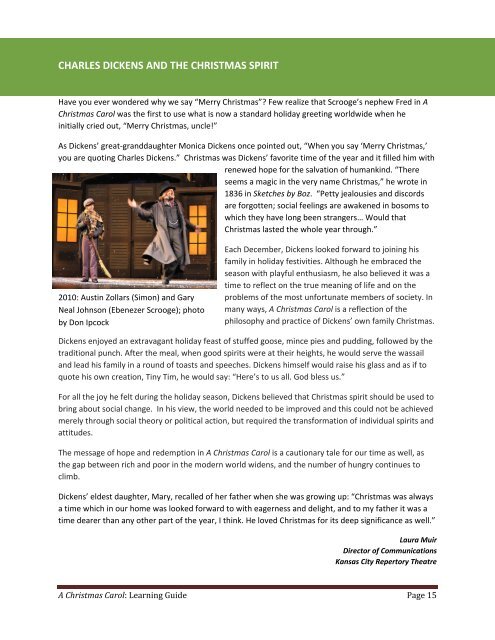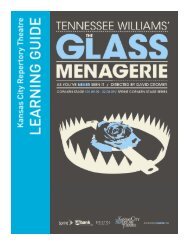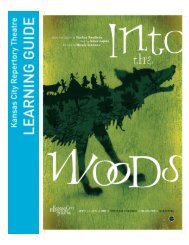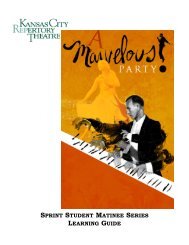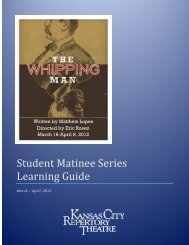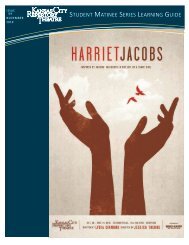A Christmas Carol - The Kansas City Repertory Theatre
A Christmas Carol - The Kansas City Repertory Theatre
A Christmas Carol - The Kansas City Repertory Theatre
You also want an ePaper? Increase the reach of your titles
YUMPU automatically turns print PDFs into web optimized ePapers that Google loves.
CHARLES DICKENS AND THE CHRISTMAS SPIRIT<br />
Have you ever wondered why we say “Merry <strong>Christmas</strong>”? Few realize that Scrooge’s nephew Fred in A<br />
<strong>Christmas</strong> <strong>Carol</strong> was the first to use what is now a standard holiday greeting worldwide when he<br />
initially cried out, “Merry <strong>Christmas</strong>, uncle!”<br />
As Dickens’ great‐granddaughter Monica Dickens once pointed out, “When you say ‘Merry <strong>Christmas</strong>,’<br />
you are quoting Charles Dickens.” <strong>Christmas</strong> was Dickens’ favorite time of the year and it filled him with<br />
renewed hope for the salvation of humankind. “<strong>The</strong>re<br />
seems a magic in the very name <strong>Christmas</strong>,” he wrote in<br />
1836 in Sketches by Boz. “Petty jealousies and discords<br />
are forgotten; social feelings are awakened in bosoms to<br />
which they have long been strangers… Would that<br />
<strong>Christmas</strong> lasted the whole year through.”<br />
2010: Austin Zollars (Simon) and Gary<br />
Neal Johnson (Ebenezer Scrooge); photo<br />
by Don Ipcock<br />
Each December, Dickens looked forward to joining his<br />
family in holiday festivities. Although he embraced the<br />
season with playful enthusiasm, he also believed it was a<br />
time to reflect on the true meaning of life and on the<br />
problems of the most unfortunate members of society. In<br />
many ways, A <strong>Christmas</strong> <strong>Carol</strong> is a reflection of the<br />
philosophy and practice of Dickens’ own family <strong>Christmas</strong>.<br />
Dickens enjoyed an extravagant holiday feast of stuffed goose, mince pies and pudding, followed by the<br />
traditional punch. After the meal, when good spirits were at their heights, he would serve the wassail<br />
and lead his family in a round of toasts and speeches. Dickens himself would raise his glass and as if to<br />
quote his own creation, Tiny Tim, he would say: “Here’s to us all. God bless us.”<br />
For all the joy he felt during the holiday season, Dickens believed that <strong>Christmas</strong> spirit should be used to<br />
bring about social change. In his view, the world needed to be improved and this could not be achieved<br />
merely through social theory or political action, but required the transformation of individual spirits and<br />
attitudes.<br />
<strong>The</strong> message of hope and redemption in A <strong>Christmas</strong> <strong>Carol</strong> is a cautionary tale for our time as well, as<br />
the gap between rich and poor in the modern world widens, and the number of hungry continues to<br />
climb.<br />
Dickens’ eldest daughter, Mary, recalled of her father when she was growing up: “<strong>Christmas</strong> was always<br />
a time which in our home was looked forward to with eagerness and delight, and to my father it was a<br />
time dearer than any other part of the year, I think. He loved <strong>Christmas</strong> for its deep significance as well.”<br />
Laura Muir<br />
Director of Communications<br />
<strong>Kansas</strong> <strong>City</strong> <strong>Repertory</strong> <strong>The</strong>atre<br />
A <strong>Christmas</strong> <strong>Carol</strong>: Learning Guide Page 15


